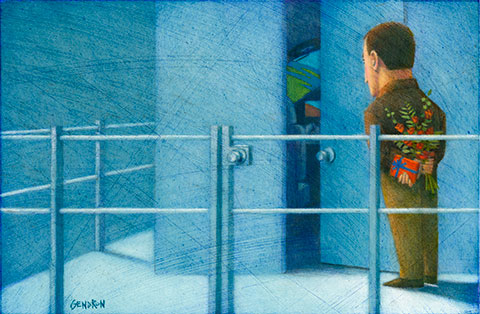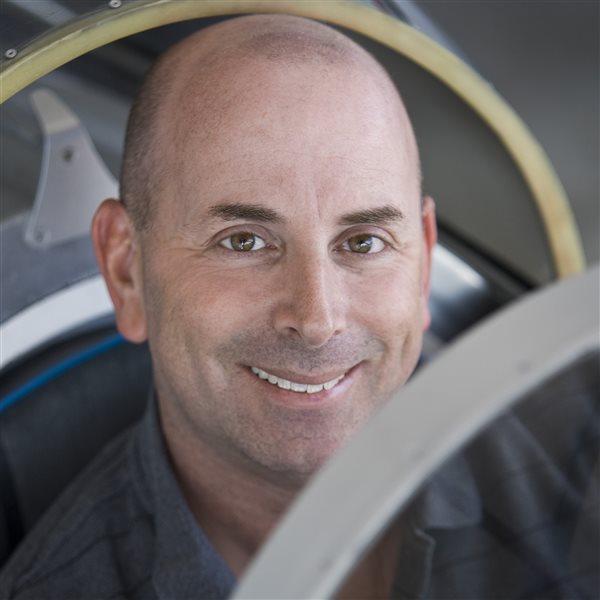
Illustration by cathy gendron
The red master warning light gives us the bad news 38,000 feet over Bimini. The pressurization system in our Cessna CE-525 Citation Jet has failed on a night flight to Miami, and it’s time to hustle down to an altitude where we can remain conscious without supplemental oxygen.
AOPA Senior Editor Al Marsh is in the left seat and he banks sharply left, pulls the throttles to idle, and deploys the speed brakes. As the nose drops and the airspeed increases, I set the autopilot to maintain 240 KIAS all the way down to an altitude of 3,000 feet over the dark Atlantic Ocean, and declare an emergency.
The rate of descent exceeds 6,000 fpm during our plunge, but the autopilot doesn’t seem to mind, and the airplane levels off smoothly on an easterly heading. We’re quickly cleared for an ILS approach to Runway 8R at Miami International Airport where the weather, naturally, is at minimums: a ceiling of 200 feet and a half-mile visibility. But just 12 minutes after the depressurization warning, Marsh squeaks the wheels down softly and brings us to a stop on the rain-slicked runway.
Actually, we’ve been stopped the whole time, although the realistic sensations inside the Level C simulator at SimCom’s Orlando training center sure could have fooled me.
“Switch seats and let’s do all that again,” says Ed Taylor, SimCom training director, a gruff, former U.S. Navy submariner and veteran pilot and instructor who has helped transform thousands of piston-engine pilots into jet and turboprop fliers. “That wasn’t bad for an initial effort.”
Marsh and I are halfway through the second day of SimCom’s five-day jet transition course. The experience is meant to provide prospective jet pilots and owners a taste of what they can expect in longer and more rigorous type-rating courses. (The CE-525 initial course takes two weeks; or eight days for pilots already rated in a similar Cessna jet.)
Each day in the jet transition course is split between classroom and simulator sessions. And, as with Marsh and me, there usually are two students and one instructor. (Veteran SimCom instructor Bob Orton assisted Taylor with us.)
The classroom sessions gave an overview of the FARs; jet engines; RVSM; operating manuals; fuel, electrical, and hydraulic systems; flight management; performance calculations; and high-altitude physiology. Although the instructors were highly qualified, extremely knowledgeable, and armed with an endless array of PowerPoint slides, I struggled (and largely failed) to make sense of the electrical and hydraulic schematics. Things that seem obvious to engineers, such as the natural path of electrons given a maze of diodes, breakers, and switches, mean next to nothing to writers like me. (But the exercise was valuable in that it showed I’d be wise to bone up on those areas in advance of an actual type-rating course.)
As dry as the classroom sessions are, the simulator time is just the opposite.
The moving platform and expert instructors make the experience challenging, dynamic, and incredibly lifelike. It’s easy to lose yourself in the experience and forget that you’re really on the ground, and not over Aspen, Atlanta, the Bahamas, or some of the other places we visited virtually.
Flying the simulator is valuable, too, because it answers the most fundamental questions that I imagine most piston-engine aircraft pilots have when they approach a jet for the first time: “Am I capable of flying this thing?” and “Will I enjoy it?”
Like most piston-engine pilots, I’ve always suppressed my desire to fly jets because such airplanes, and the training required to fly them, was always out of reach. I was thrilled to be able to fly the piston airplanes I had access to.
But with growing AOPA member interest in owner-flown turbine aircraft issues, I began looking for ways to better educate myself about these formerly foreign concepts. SimCom, which specializes in owner-flown turbine aircraft, seemed like the perfect place to get the educational foundation I needed. Turns out, it was.
During our first simulator session, the instructors took it easy on Marsh and me. We went through the normal checklists and procedures for starting engines, taxiing, taking off, and landing in both visual and instrument conditions.
I was relieved to find that actually flying the airplane (or the simulator, in our case) was easy and pleasant from a stick-and-rudder perspective when all the systems were working properly. It takes awhile to get accustomed to having so much speed and power available—and for pilots like me accustomed to having too little of those vital things, too much is a welcome luxury.
It also takes longer for the airplane to fully respond to changes in power settings. But with a few target power settings for different configurations firmly in mind, and forgivingly high gear and flap speeds, flying by the numbers was doable from day one.
“The CJ1 is more complex, system-wise,” Taylor said. “But it flies like a 182. Power management is the big weakness among piston-engine aircraft pilots at first. But the airplane itself is fun to fly and it’s easy to fly.”
Also, I was a bit surprised to find that there’s far more sophistication and capability in the integrated avionics suites for single-engine piston aircraft such as a Cirrus or Corvalis than a legacy CE-525 like the one our simulator replicated. Any Garmin G1000 or Avidyne Entegra R9 system, for example, offers weather, traffic, and terrain tools far more advanced than the vaunted, but decades-old, Part 25 jet’s instrument panel. Things such as WAAS-enabled GPS, synthetic vision, and dual AHRS were still in the future when the Cessna simulator was built.
And the checklists were surprisingly short at times, with no cowl flaps, mixture knobs, or prop levers to adjust.
On our second day of simulator training, things got much more challenging with a series of emergencies that illustrate some of the demands peculiar to jet flying. There were engine failures slightly before, and slightly after, V1; engine fires during climb and cruise; and generator and flap failures, as well as the depressurization.
The hard part for a piston pilot like me was slowing down. Instead of the rapid “identify, verify, feather” drill in piston twins, Taylor counseled a more patient and deliberate method of problem solving. “Don’t get too concerned about that engine-fire light,” he said. “Remember jet engines are always on fire. It’s just that sometimes the fire’s on the inside, and sometimes it’s on the outside.”
Marsh and I would perform the memory items, then force ourselves to refer to the spiral-bound emergency procedures checklist and work our way through each scenario. The situations in which we hurried were the ones in which we compounded our problems.
Taylor brought that point home to us by saying our main shortcoming, as with most GA pilots making the same transition, is discipline. “The reason jets are safer is that we do things the same way every time,” he said. “Fly by the numbers, and use proven procedures, and things have a way of working out. When you start hurrying or improvising, you’re asking for trouble.”
Marsh and I had been flying as a team throughout the course with the left-seater flying and the right-seater making the radio calls, raising and lowering the gear and flaps, and operating the avionics.
On our final sim session, I wanted to get a flavor of flying the jet as a single pilot. Marsh was in the right seat for moral support, and to hold the checklist and flashlight, but that was going to be the limit of his involvement. I assumed Taylor would kindly allow me a virtual victory lap by keeping both engines running for a few normal takeoffs, landings, and instrument approaches. Instead, the next 90 minutes were filled with failed engines, runaway pitch trim, and single-engine missed approaches. I was sweating despite cool temperatures inside the sim, and Marsh and Taylor seemed to delight in my torment.
I missed my co-pilot’s airspeed callouts on takeoff, avionics tuning, checklist assistance, and more. By myself, I felt woefully behind the airplane at times as the emergencies cascaded. But the experience was a confidence builder, too.
It became clear during the five-day course—and especially the last sim session—that flying a multiengine business jet isn’t magic, and it’s not beyond the ability of piston GA pilots. The procedures can be learned (and even begin to make sense) with some effort. And learning new skills and implementing them is both challenging and fun.
More than 90 percent of the pilots who attend SimCom’s initial type-rating courses pass, although they must work intensively to do it. I’m not sure when, or if, I’ll have the chance to develop or implement these fledgling jet skills. But my aviation experiences to date have proven that opportunities have a way of presenting themselves to those who prepare for them, and that the journey itself is the reward.
A week at SimCom showed me that learning to fly a jet is doable. And actually flying one would be a blast. (Pun intended.)
Email the author at [email protected].



